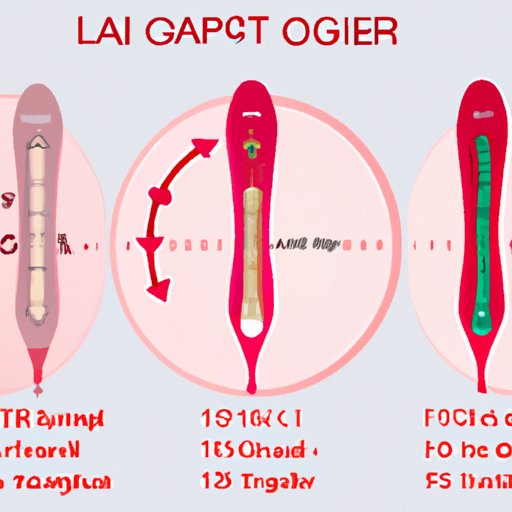
Introduction
Ovulation is the release of an egg from the ovaries, and this process is essential for conception. Every woman’s menstrual cycle is unique, so it may not always be easy to know when you are ovulating. However, knowing your ovulation pattern can significantly increase your chances of conception, especially if you’re trying to get pregnant. In this article, we will discuss some effective ways to determine if you are ovulating.
Tracking Your Menstrual Cycle
One of the most effective ways to identify your ovulation pattern is by tracking your menstrual cycle. This method involves keeping records of your menstrual period, including the start and end dates. Monitoring your menstrual cycle lets you predict when your next period will begin and provide insight into when you are ovulating.
Two methods of tracking your cycle are recommended; marking the days on your calendar and using period tracking apps on your phone. Most period apps remind you to input data on each missing day and come with additional features such as alerts for expected periods, and such complement your data tracking efforts.
Once you have enough data, you can pinpoint your ovulation by counting backward fourteen days from the expected date of your next menstrual period. This backward counting method gives an estimated ovulation date, indicating your most fertile period.
Paying Attention to Your Body
Another way to tell if you are ovulating is by paying attention to your body. Ovulation comes with some physical symptoms, such as bloating, tender breasts, and changes in cervical mucus. Detecting these changes is a good way to track ovulation.
Some women may experience bloating, increased sensitivity in the breasts, and other mild symptoms during ovulation. Changes in cervical mucus – the vaginal discharge – are also significant signs of ovulation. Increased and clear vaginal discharge indicates ovulation, but noting its onset and tracking its changes is necessary. The changes observed in these symptoms will help ladies track their cycles accurately.
Taking an Ovulation Test
Over-the-counter ovulation tests are a popular way to test for ovulation. These tests work by detecting a surge in Luteinizing hormone (LH) – one of the various hormones produced in the female genital system – that occurs a day or two before ovulation. This LH surge is what triggers ovulation.
Ovulation tests are available in drugstores and usually come in packs that test various days at a time. The use of an ovulation test should target to identify the two days in the woman’s cycle when she is most fertile.
While ovulation tests can help predict ovulation, they are not always 100% reliable. In some cases, your LH may surge, but ovulation may not occur; additionally, the test can produce false-positive readings in some cases.
Using a Basal Body Temperature Thermometer
Basal body temperature is the body’s lowest temperature, which occurs during prolonged inactivity or just after waking up from sleep. Using a basal body thermometer is a reliable and inexpensive way to determine ovulation.
Before ovulation, your basal body temperature is slightly lower, and after ovulation, it rises slightly and remains high until the next menstrual cycle. So, if you take your temperature every day and notice a slight uptick, that could indicate you are ovulating.
Note that you must take your temperature at the same time every day to ensure consistent results. Additionally, factors such as alcohol consumption, stress, or lack of sleep can alter the reading.
Checking Your Cervical Position
Women can also check their cervical position to determine ovulation. The cervix undergoes various changes during the menstrual cycle, and these changes can help indicate when ovulation is about to occur. Checking your cervical position is an exciting way to predict ovulation without relying on external factors.
To check your cervical position, first, wash your hands and find your cervix using your fingers. Then, notice the texture and opening width. When you are ovulating, your cervix will be high, soft, and the opening width will be wider than usual, all pointing to improving chances of fertility.
Consulting with Your Doctor
If you have trouble tracking your ovulation or have any underlying fertility issues such as thyroid conditions, it is best to speak to a medical professional. Sometimes, they may recommend that you undergo testing to determine the underlying cause of your fertility issues, and specific treatments might be prescribed depending on the causes discovered.
Conclusion
In conclusion, determining ovulation can help you conceive if you’re trying to get pregnant. Tracking your menstrual cycle, paying attention to your body, using an ovulation test, taking basal body temperatures, checking cervical position, or consulting with your doctor can all help you determine ovulation. We encourage ladies trying to get pregnant to try different methods. By frequent use, couples can predict the woman’s fertile period with a higher probability of success, enhancing their chances of conception.
Closing Thought: While trying to conceive, it is essential to remain patient and focus on your techniques, and keep in mind that conception can take time. Don’t hesitate to consult medical professionals if you experience difficulties conceiving.





